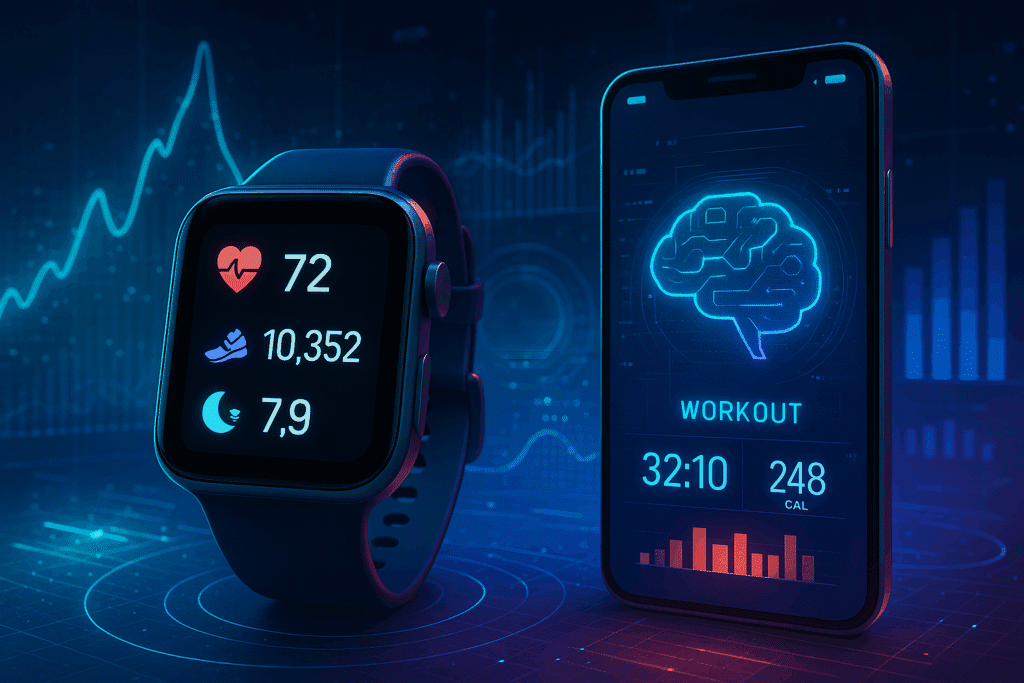Top Fitness Trends 2025 – Wearables, Apps, and Data-Driven Training
Fitness experts are tracking several emerging trends shaping workouts in 2025. Chief among these is wearable technology. According to the American College of Sports Medicine’s annual survey, wearable devices (smartwatches, fitness trackers, heart monitors) ranked #1 fitness trend for 2025. Wearables can track steps, heart rate, sleep patterns and more, giving users real-time feedback and motivation. The ubiquity of these devices – a vast majority of fitness apps link to wearables – has made personal health data a core part of exercise planning.
Closely related are mobile exercise apps (trend #2 for 2025). Millions of people now follow workouts on smartphone apps, from guided HIIT routines to yoga and meditation sessions. For instance, fitness apps saw 850 million downloads and 370 million users in 2023. These apps often integrate with wearables, creating a seamless experience: users can track progress, join challenges, or even stream live classes anywhere. The surge in app-based fitness has accelerated after the pandemic, as more trainers and gyms offer virtual classes globally.
Another big trend is data-driven training. Advanced apps and gym equipment now analyze users’ biometrics – such as heart rate variability and sleep quality – to personalize workouts. Trainers and algorithms adapt exercise intensity in real-time for optimal results. For example, data-driven programs might prescribe lighter exercise on days when sleep was poor, reducing injury risk. This scientific approach helps both elite athletes and everyday exercisers train smarter and safely.
The 2025 trends list also highlights the popularity of targeted training programs. Workouts for specific goals – such as “Exercise for Weight Loss”, “Mental Health”, or “Older Adults” – feature in the top trends. Tailored classes (online or in-person) meet the diverse needs of different groups, from seniors needing joint-friendly routines to busy professionals seeking stress-relief yoga. Additionally, high-intensity interval training (HIIT) and strength training remain popular for their time efficiency and health benefits.
For fitness enthusiasts, these trends mean more personalized and tech-enabled options than ever. By 2025, nearly everyone can find a convenient way to move: whether it’s a smartwatch nudging you to stand up after long meetings, an on-demand workout in your living room, or a group class in your age range. As one ACSM expert notes, digital technology is “creating avenues for reaching new clientele and elevating fitness experiences.”. To stay motivated, consider trying a fitness app or wearable if you haven’t, or seek out programs that fit your lifestyle. The modern gym might be your wrist, phone, or community center – and the science of exercise is now highly personalized and data-driven.

Conclusion
The rise of these fitness trends in 2025 reflects a broader shift in how people view health and exercise. No longer limited to gyms or scheduled classes, fitness is becoming more flexible, tech-enabled, and accessible. The blending of wearables, mobile apps, and data-driven training creates a hybrid fitness environment where individuals can train anywhere while still receiving tailored, professional guidance. This democratization of fitness means that more people – regardless of age, location, or income – have entry points into healthy lifestyles.
Another factor driving these trends is community engagement. Many apps and wearables now emphasize social features such as challenges, leaderboards, and progress sharing. These gamified elements foster accountability, motivating users to stay active while connecting with like-minded people worldwide. Fitness is becoming not only an individual pursuit but also a shared cultural experience.
Environmental and wellness awareness also play a role. Outdoor group workouts, eco-friendly gyms, and mindful fitness approaches (like yoga or tai chi combined with meditation apps) are growing. By integrating mental wellness and sustainability into physical activity, 2025’s fitness culture embraces a holistic view of health. Looking forward, the combination of science, technology, and community promises to redefine how society approaches wellness in the digital age.
Explore more insights in our Health & Fitness section.
Further Reading
- American College of Sports Medicine – Fitness Trends Survey
- World Health Organization – Global Physical Activity Guidelines
- Harvard Health – Data-Driven Exercise Benefits
- Forbes – Wearable Tech in Fitness
- Statista – Fitness App Usage and Growth
